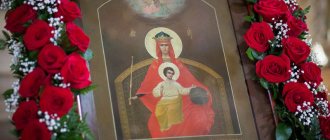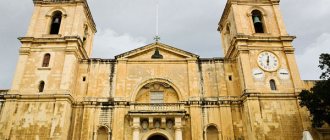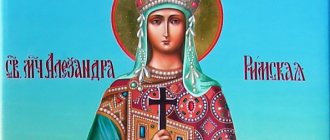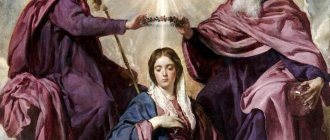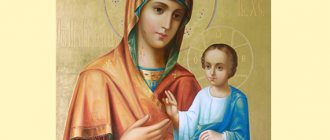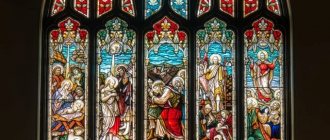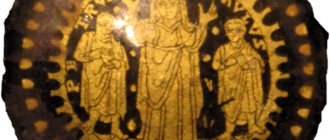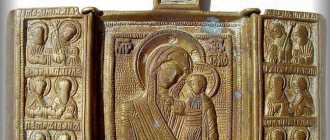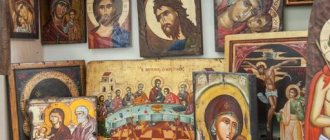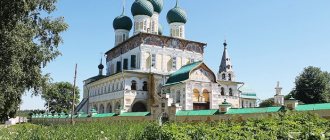One of the oldest images of the Mother of God is considered to be the icon of the Mother of God “Oranta” (Praying). Another name that is often found is the icon of the Mother of God “Panagia” (All-Holy). In terms of iconographic type, the “Great Panagia” icon goes back to the famous Blachernae icon of the Mother of God from Constantinople.
In Russia, the most ancient icon of this type is the “Yaroslavl Oranta” (“Great Panagia”), which, according to legend, was painted by the first Russian icon painter, the Monk Alypius, a monk of the Pechersk Monastery in Kyiv.
Description of the icon
Traditionally, the icon of the Mother of God “Oranta” depicts the Mother of God with her arms raised and outstretched to the sides, with Christ Emmanuel in a circle on her chest, who also has his arms outstretched in a blessing gesture, which is rare: as a rule, on the icons of the Mother of God the Child or the Youth Christ is blessed with one hand .
The name “Emmanuel” is borne by any image of the Savior in adolescence, including on icons of the Mother of God. His look is filled with childish seriousness, and the look of the Mother of God is filled with meekness and humility before the Will of God.
Subsequently, the same type of iconography became characteristic of the icons of the Mother of God “The Sign”, “The Life-Giving Spring” and “The Inexhaustible Chalice”.
The “Panagia Sumela” icon belongs to a slightly different iconographic type, which is also classified as an “Oranta” (“Panagia”) type. This is a half-length image of the Mother of God with Jesus on her knees.
This icon has its own dramatic story. Tradition says that this face was painted by Saint Luke himself. Miraculously, the icon ended up on a bare rock ledge, and the Mother of God herself ordered two Greek monks to build an Orthodox monastery here, called Sumela. This happened in the 4th century, and since then it has become widely known as the monastery of Our Lady of the Black Mountain.
Humility is the basis of Christian spirituality
It is important to understand the sacred, sacred meaning that is inherent in this image of the Mother of God. Nowadays it is fashionable to talk about spirituality. But what is spirituality in the Orthodox understanding? The basis of spirituality, according to the teachings of the holy fathers of the church, is humility. Humility is a person’s complete acceptance of God’s will for the sake of achieving his salvation. This is exactly what the Most Holy Virgin, depicted on the Oranta icon, revealed. Every Christian should know about this.
One of the oldest images of the Mother of God is considered to be the icon of the Mother of God “Oranta” (Praying). Another name that is often found is the icon of the Mother of God “Panagia” (All-Holy). In terms of iconographic type, the “Great Panagia” icon goes back to the famous Blachernae icon of the Mother of God from Constantinople.
In Russia, the most ancient icon of this type is the “Yaroslavl Oranta” (“Great Panagia”), which, according to legend, was painted by the first Russian icon painter, the Monk Alypius, a monk of the Pechersk Monastery in Kyiv.
The meaning of the icon of the Mother of God “Oranta”
In iconography, each element of the image has its own meaning. Thus, on the icon of “Theotokos Oranta,” the raised hands of the Mother of God are turned with their palms towards Heaven, which symbolizes her intercession before the Creator for every, even sinful, soul.
On the sleeves of the Mother of God there are bands in the form of wide ribbons with cords that tighten the sleeves at the wrist.
This element of the liturgical vestments of priests symbolizes the patronage and service of the Orthodox Church
In the view of the Orthodox, the Panagia icon expresses the basic Christian dogmas, which include the virgin birth and the two essences of Jesus Christ - Divine and Human. Here Christ Emmanuel personifies the Eucharist - the main church sacrament of communion with the Body and Blood of Christ.
Iconography
The image has been known since antiquity, when it was closely associated with decorative art, which includes monumental forms of sculpture, mosaics and various frescoes. The first copies were created without the face of Christ the Youth on the Mother’s chest. After the iconoclastic period, the image of the “Praying” Virgin Mary spread into the design traditions of Byzantine and Russian churches.
- In the “Oranta” iconographic type, the Mother of God is shown full-face, full-length or half-length. This includes not only holy images, but also various monuments, as well as complex compositions on gospel themes.
- The Most Pure Virgin stretching out her hands in a prayerful pose is a symbol of forgiveness of the human race. On the sleeves of the clothing of the central figure of the canvas, wide ribbons-handrails with laces are visible, which are designed to tighten the fabric at the wrist. This element of church attire is a symbol of faithful service to Christianity.
More about the icons of the Mother of God:
Prayer to the miraculous icon
The Most Pure Mother of God is always the Heavenly Intercessor of Christians, the Patroness of states pursuing the correct policy.
The “Praying” Virgin Mary, expressing endless mercy, is addressed to save the soul from falling into the abyss of sinfulness, as well as for healing from various serious illnesses arising from the wrong way of thinking and acting.
Important! If a person with pure intention and frankness turns to the holy face of “Panagia”, he will definitely receive support from the merciful Mother of God.
The icon called “Oranta” has amazing power. Prayers addressed to this painting help the believer gain a correct understanding of the existing order of things, come to enlightenment that brings him closer to the Lord, and also remove the evil intentions of enemies. The power of the “Praying” Virgin Mary is capable of covering entire states from attack.
In the direct prayer petition, praise is offered to the Heavenly Patroness. It says here that people place their main hope in the Most Pure Virgin. Sufferers ask for deliverance from sorrows and sorrows, protection from the harmful effects of passions and inspiration on the path to the throne of the Almighty Creator. Saint Mary is implored to disperse the darkness of misunderstanding and instill in the hearts the light of clear awareness. Finally, She is asked to intercede for humanity before God and never abandon devoted Christians.
How do the Oranta (Panagia) icons help?
The Mother of God has always been the Heavenly Intercessor, the Patroness, and for this they turn to Her, praying for the salvation of the soul, for the healing of physical and mental ailments, for support in moments of difficult life trials, and she really helps.
The Oranta-Panagia icons have incredible power of influence: they help to gain a clear understanding of the true path, bestow spiritual enlightenment, and protect from the evil thoughts of enemies. The power of the Oranta icon is so great that it is capable of protecting entire countries from enemy attack; it is not for nothing that the Queen of Heaven appears on it in all Her greatness and power.
Meaning of the image
The holy image of "Oranta" or "Panagia" demonstrates the merciful Virgin Mary, who raises her right hands to heaven, asking the Lord for forgiveness for all human sins. People turn to the canvas in the hope that the Mother of God will intercede with God and help avoid suffering.
The “praying” icon is a symbol of intercession and saves everyone who is sincere in their morality.
Oranta is one of three types of iconography of the Virgin Mary. It contains the two natures of Jesus Christ: the image of man and divinity. The Mother of God herself is depicted in the traditional gesture of intercessory prayer, symbolizing her patronage.
As you know, “Oranta” is one of the types of images of the Mother of God. The Yaroslavl Icon of the Blessed Virgin is the most famous and revered image of the Mother of God from this group. This shrine also has the name “Great Panagia”. They turn to the face of the Mother of God in prayers for the salvation of the soul, asking for the intercession and protection of the Mother of God.
History of the Icon of the Mother of God
Translated from Latin, “Oranta” means “Praying One”. Icon painters depicted this image of the Virgin Mary in ancient times. The image of Our Lady "Oranta" originates in the Roman Empire. Even then, this type of holy image gained enormous popularity.
Currently, icons of the Mother of God “Oranta” decorate churches and cathedrals in many countries around the world. The Orthodox people pay homage to this image and pray in front of the Oranta icons, asking for help and support on the path of life.
The true meaning that the image of the Mother of God “Oranta” conceals lies in the unity of the peoples of all countries and generations, carrying within themselves lives and destinies that have come into contact with the mystery of this holy image, with the source of light and love, with the spiritual power of the Mother of God.
Famous icons of the Virgin Mary
The shrines of the “Oranta” iconographic type include famous images of the Mother of God, known throughout the world:
It is also worth noting the famous fresco of the Virgin Mary of the “Oranta” type, called “The Unbreakable Wall”. It is located in the Kiev Cathedral of St. Sophia. Pilgrims and ordinary believers come to the cathedral to see the miracle with their own eyes and touch the image filled with mystery and grandeur. The fresco contains a plot from the Annunciation scene. It depicts the Archangel Gabriel and the Blessed Virgin - faithful intercessors and patrons of the Kyiv lands.
How do Oranta icons help?
The icons of the Oranta group contain incredible power and work real miracles. In front of shrines, Orthodox people pray for support in difficult moments of life, for healing from diseases of various types.
Oranta icons can guide a person on the right path, help a person gain spiritual enlightenment and fill the heart with love for the Lord. Also, the holy image of “Orant” drives away evil spirits and enemies and protects entire countries from the attacks of enemies.
Description of the holy image
Traditionally, icons of the “Oranta” type depict the Mother of God. Her arms are raised up and spread out to her sides. The palms of the Mother of God are open and turned to Heaven. The Mother of God can be depicted either in full height or waist-length. Usually at the shrines of the Oranta group there is a Divine Infant. The raised hands of the Mother of God symbolize prayer before the Lord for every soul, and the baby symbolizes the Sacrament of the Body and Blood of Christ, also called the Eucharst. The image of the handrails on the hands of the Mother of God carries a symbol of the patronage of the Orthodox Church and service to the Heavenly Father.
Prayer before the holy image
“Oh, our illustrious intercessor, the Most Holy Theotokos! We offer our prayers to You! Our only hope is in You! Come to the aid of us sinners, help us cope with grief and sorrow! Protect us from evil, protect our homeland from enemies and do not let us lose heart, O Holy Virgin! Guide us on the righteous path, fill our souls with light! Drive out the darkness from our hearts and the demons that have settled in our bodies! You are our only protector! Our salvation is in You! Pray before the Lord for our sins, grant us repentance and Your forgiveness! Be near and do not leave us, for we will glorify Your name, Queen of Heaven! Let God's will be done for everything. In the name of the Father, and the Son, and the Holy Spirit. Amen".
Prayers to the Mother of God will help you not to go astray, cleanse your soul and find true happiness. There are many icons of the Mother of God in the world, and each of them is like a separate form of art. But the images of the holy group “Oranta” are not just a beautiful image of the Mother of God’s face. This is a sacrament that shows us how strong the love and help of the Mother of God is for each of us. We wish you strong faith, take care of yourself
The Oranta icon is one of the most famous icons depicting the Mother of God. A special relationship connects a Russian Orthodox person with the Mother of God. She has long become an intercessor and patroness for Rus'. The main churches of the Russian state were dedicated specifically to her, which is why the image of the Mother of God is always especially revered in Russian Orthodox churches. In the entire pantheon of Orthodox saints, there is no one to whom so many icons and monumental paintings are dedicated.
Prayer before the icon
Oh, Most Holy and Most Blessed Mother of our Sweetest Lord Jesus Christ! We fall down and worship You before Your holy, miraculous icon, remembering the wondrous sign of Your intercession, which was revealed to the great Novograd during the days of the invasion of this city. We humbly pray to You, the All-Powerful Intercessor of our race: just as You hastened our fathers of old to help, so now we, weak and sinners, grant Your Motherly intercession knowledge and care. Save and preserve, O Lady, under the roof of Your mercy, the Holy Church, Your city, our entire Orthodox country and all of us who fall to You with faith and love, tenderly asking with tears for Your intercession ́nia. Hey, All-Merciful Lady! Have mercy on us, overwhelmed by many sins, extend your God-receiving hand to Christ the Lord and intercede for us before His goodness, asking us for forgiveness of our sins, pious peace His life, a good Christian death and a good answer at His Last Judgment, yes, we are saved by Your omnipotent Through our prayers, we will inherit the bliss of paradise and with all the saints we will sing the Most Honorable and Magnificent Name of the Venerable Trinity, the Father and the Son and the Holy Spirit, and Your greatness is merciful to us die forever and ever. Amen.
( 4 ratings, average: 4.25 out of 5)
